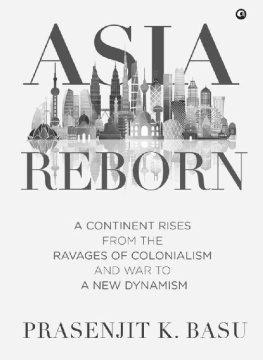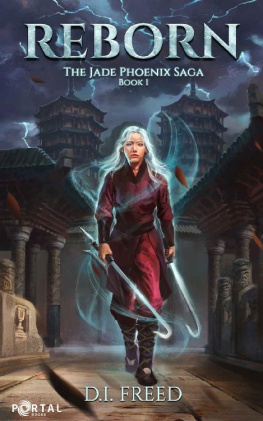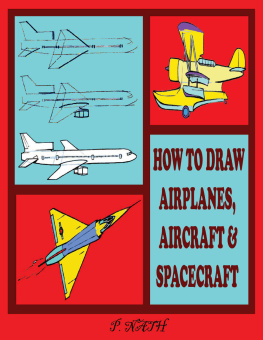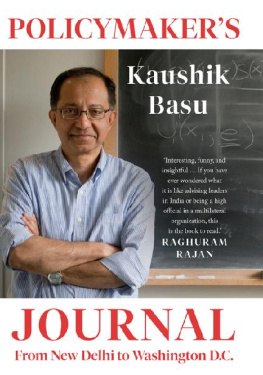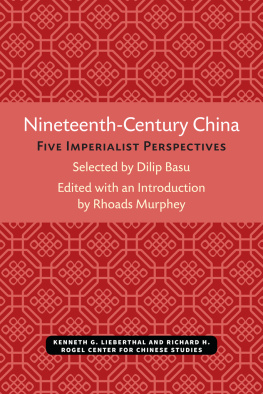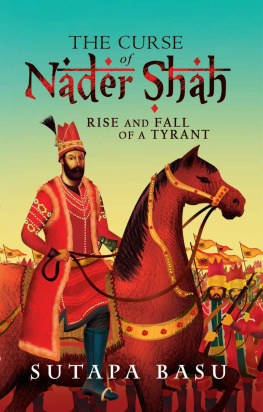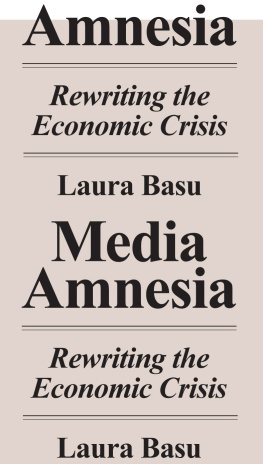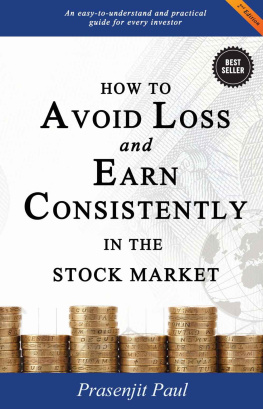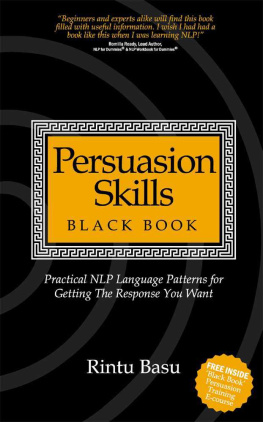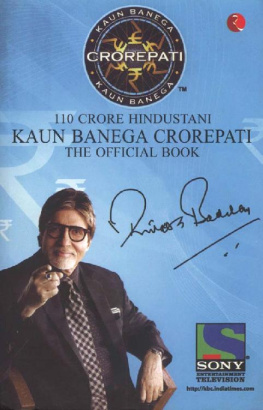ASIA REBORN
ALSO BY PRASENJIT K. BASU
India as a New Global Leader
(with Brahma Chellaney, Parag Khanna and Sunil Khilnani)
ALEPH BOOK COMPANY
An independent publishing firm
promoted by Rupa Publications India
First Published in India in 2017
by Aleph Book Company
7/16 Ansari Road, Daryaganj
New Delhi 110 002
Copyright Prasenjit K. Basu 2017
Cover illustration: Shutterstock/Lisa Kolbasa
Maps and photos: Wikimedia Commons,
Creative Commons License
All rights reserved.
The views and opinions expressed in this book are the authors own and the facts are as reported by him, which have been verified to the extent possible, and the publishers are not in any way liable for the same.
While every effort has been made to trace copyright holders and obtain permission, this has not been possible in all cases; any omissions brought to our attention will be remedied in future editions.
No part of this publication may be reproduced, transmitted, or stored in a retrieval system, in any form or by any means, without permission in writing from Aleph Book Company.
ISBN: 978-93-84067-19-9
1 3 5 7 9 10 8 6 4 2
This book is sold subject to the condition that it shall not, by way of trade or otherwise, be lent, resold, hired out, or otherwise circulated without the publishers prior consent in any form of binding or cover other than that in which it is published.
This book is dedicated to
The pioneer
Ito Hirobumi
The pathfinders
Takahashi Korekiyo and Kishi Nobusuke
The liberators
Subhas Bose and M. K. Gandhi, Sukarno, Aguinaldo, Aung San, Zhou Enlai and Liu Shaoqi, Sun Yat-sen and Lee Teng-hui, Phibunsongkhram, Ahmed Boestamam, Atatrk, Mossadegh
The builders
Lee Kuan Yew, Park Chung-hee and Kim Dae-jung, Deng Xiaoping, Mahathir, Narasimha Rao and Narendra Modi
CONTENTS
PROLOGUE
This book is an Asian telling of Asias story in the twentieth century.
The twentieth century was both the most creative and the most destructive in human history. Humankind achieved extraordinary advances in scientific and technological achievement. Almost everything we consider necessities in todays consumer society (cars, televisions, computers, phones, tablets, etc.) was virtually unknown at the start of the century. And, yet, the century was unprecedented in its destructive force: two World Wars that brought untold destruction (including pogroms such as the Jewish Holocaust between 1938 and 1945, and the Great Bengal Famine of 194344), the great Communist killings (the pogroms of the Russian kulaks between 1929 and 1932, and the massive famine that followed Chinas Great Leap Forward between 1958 and 1961), huge wars in Korea (195053), Vietnam (196575) and the Gulf (Iran vs Iraq, 198088; Iraq vs the US, 199091), plus famine, civil war and deep-seated ideological conflicts in too many places to recount.
But perhaps the most extraordinary development of the twentieth centuryone that few would have anticipated at its startwas the flowering of new nations around the globe, and especially in Asia. Many of the great currents that swept the world during the twentieth century had huge reverberations in Asia. But few could have imagined that this vast continentseemingly inert and supine at the start of the centurywould rise anew by the year 2000 and stand poised to re-emerge in the position of leadership that it held a millennium ago, but had largely surrendered by 1800.
This book seeks to tell the story of the renaissance of Asia during the twentieth century. One would expect this to be a well-chronicled tale, but it is a story that has hardly ever been told collectively. A single narrative about Asia is still considered inappropriate, because the Western media has led the world to believe that Asia is riven with deep-seated cultural differences that make it something less than a continent. A cursory traveller around the region would know that this assertion of divergence is absurd: the practice of popular religion has enormous similarities in China, Cambodia, Thailand, India, Indonesia and Japan; rice is a common thread that runs from eastern and southern India all the way to southern China (and all points in between), Korea and Japan; and the list can go on.
The historic experiences of the Asian continent have also been largely shared. Buddhism remains a source of cultural unity from Burma to Japan (with Thailand, Sri Lanka, Mongolia, Singapore and much of China thrown in), and before its advent much of Asia was bound together by the mythological legacies of the Ramayana (which continue to influence Cambodia, Indonesia, India, Thailand). The depredations of the Mongols affected virtually all of Asiafrom China and Korea to present-day Russia, Iran and Iraq, and points in between. The kamikaze wind blew the Mongol navy away from the shores of Japan, but descendants of Genghis Khan ruled China (grandson Kublai was the emperor who united north and south China), Persia (where Genghiss descendants became Shiites and are still represented amongst Afghanistans Hazaras) and, many generations later, India (where Babur was a descendant of Genghis on his mothers side and Timurlane on his fathers). Common historical experiences, mythology, food preferences and religious practicesthese factors apart from geography are surely enough to justify the classification of Asia as a continent.
But the triumph of European colonialism in the nineteenth century helped obscure much of Asias cultural unity. At the start of the twentieth century, only Japan was not under the sway of a European colonial power: Iran, Afghanistan, Tibet, Nepal, Thailand, Korea and non-coastal China were nominally independent too, but at least partly in the thrall of one or more colonial power. The French ruled Indo-China (todays Vietnam, Laos and Cambodia) and some small enclaves in India; the Portuguese ruled Macao (on Chinas coast), Goa (on Indias) and East Timor; the Dutch ruled the East Indies (all of todays Indonesia); the British ruled India (which then included what is now Pakistan, Bangladesh and Burma), Malaya (which included Singapore), Ceylon (todays Sri Lanka), Kuwait and neighbouring Gulf states, Hong Kong and some pieces of China (the control of whose ports was divided amongst the US, Britain, France, Germany, Russia, Holland and Japan). The Philippines had just passed from Spanish to American rule (which was being fiercely resisted by some). Central Asia (todays Kazakhstan, Uzbekistan, Turkmenistan, Tajikistan and Kyrgystan), Georgia and Azerbaijan were subsumed into Russia. And the Arab lands (modern Saudi Arabia, Iraq, Syria, Jordan, Israel and Lebanon) were part of the multi-ethnic Ottoman empire, although the British and French were beginning to make inroads from their North African colonial bases.
The umbrella of colonialism (and its post-colonial and Cold War effects) masked the underlying unity of the Asian continent. The post-colonial elites were variously influenced by each of their separate colonial experiencesand only slowly rediscovered their pre-colonial identities. Some of those identities still remain very different today from the Asian mainstream (especially for the post-Soviet Republics and in Arabia), so how do we define Asia for the purposes of a book focused on the twentieth century?
Asia in its broadest definition stretches from the Arabian peninsula in the west all the way to Japan. If the old land of Palestine is included, then all the worlds religions originated in Asiaincluding the three great Semitic religions (Judaism, Christianity and Islam), which emerged at Asias western fringes. All the great Semitic religions, however, initially expanded westwards, outside Asia (apart from a brief early foray by Islam into Iran). Christianity found its home primarily in Europe and parts of North Africa (notably Egypt and Ethiopia), while Islam spread to the Levant, North Africa (Egypt, Tunisia or old Carthage, Algeria, Morocco), Spain, Sicily and Turkey well before it had established itself in the rest of Asia (India, Pakistan, Bangladesh, Indonesia, Malaysia, China, Vietnam, the Philippines). And Judaism remained a minority religion in all the lands to which it spreadin all of which Christianity or Islam was the majority religion (with the exception of Kerala on Indias west coast).



